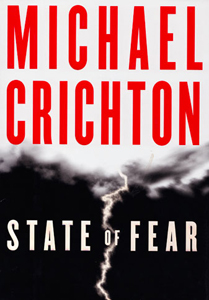With “State of Fear” (2004), Michael Crichton takes the opposite of his usual approach. Usually he peppers research into an action-adventure. Here he grafts action-adventure onto a deeply researched tome about climate-change science.
Tricky to dramatize
The author maneuvers characters, personalities and situations into conversations where he can make his points. But those points are solid. Generally: Look at peer-reviewed scientific data and studies and draw your own conclusions. Don’t take a biased person’s word for something.
But it’s a darn tricky thing to dramatize. If you see dinosaurs eating people, the counter-argument of “Don’t bring back dinosaurs” is clear. Crichton does make a robust argument that environmental groups are hurting the environment and hurting humans, but that’s not a sexy argument.

“State of Fear” (2004)
Author: Michael Crichton
Genre: Techno-thriller
Settings: Los Angeles, Antarctica, Arizona, New Guinea, 2004
It’s like arguing that the government does bad things. The counter-argument is “Yeah, but what’s the alternative? To not have a government?” Well, yes, but “doing nothing” never sells.
It’s a non-winning political position. That’s why “State of Fear” is still relevant now (when the world’s view on climate change is the same as in 2004), and always will be. It explores how it’s human nature to make excuses for things that sound good at first blush.
Fascinating experiment
“State of Fear” might’ve been better as a non-fiction work. But if nothing else, it’s a fascinating experiment as a piece of fiction.
After a slow stage-setting start, Crichton focuses on Peter Evans, one of his classic protagonists who isn’t really an Everyman (he’s a lawyer for environmental group NERF) but who slots into that role.
Uber-confident special agent (from an ill-defined agency) Kenner is immediately armed with charts and studies – like we all wish we could be when getting into debates – and Evans eventually realizes NERF is not “the good guys.”
Adding spice are two new women in Evans’ life; his relationships with them change through life-and-death situations at Earth extremes like Antarctica and New Guinea.
And we get annoying environmentalist actor Ted Bradley, who argues primitive living is better than civilized Western society; but he doesn’t practice what he preaches.
Ted might be the most cartoonish of any Crichton character. But the author puts him to entertaining use in a “gotcha” situation, similar to what Preston & Child do with their purposely over-the-top characters.
John Lange on steroids
The villains’ scheme is to continue the status quo: the belief that “we must do something” about climate change. Thus they will continue to receive paychecks and power. As noted, this doesn’t make for obvious drama, like a T-rex on the loose.
So Crichton is forced to go into extreme science fiction territory: The villains intend to create global disasters using high-tech devices, thus “proving” their point. The most remarkable is a machine that pulverizes the atoms in the ground beneath it.
It’s an overblown, unrealistic plot – a John Lange yarn on steroids. When Crichton chooses between cannibals and crocodiles, he says “Why not both?” Even Indiana Jones would say “This is too much.”

But the research is compelling. It remains the heart of a very readable novel with an appealing message that’s difficult to put into practice: Stop fearing everything.

